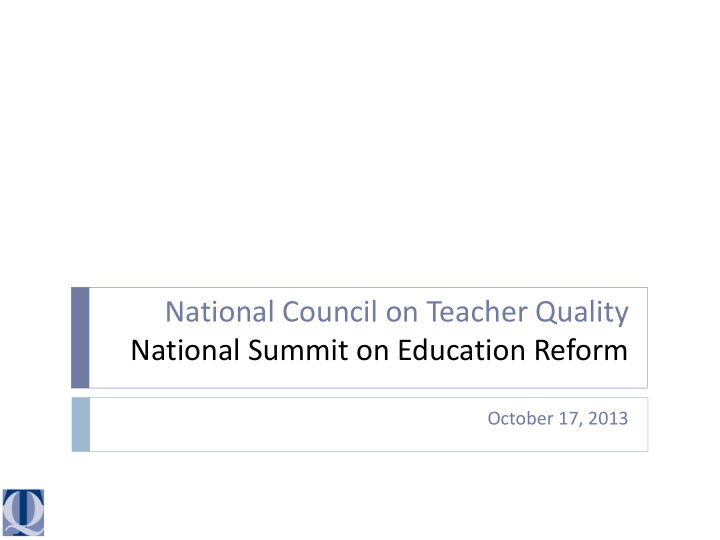



National Council on Teacher Quality National Summit on Education Reform October 17, 2013
Why teacher prep matters 98,000 new teachers hired out of higher ed each year 1.5 million students taught by a novice teacher each year The largest group of teachers is that with one year of experience NCTQ Teacher Prep Review Massachusetts July 2013
Learning loss under new teachers
Difference in the effectiveness of teachers graduating from traditional education schools versus teachers with little to no training: Slight to none
The chasm between higher education and public education
This explains a lot. Training teachers isn’t the responsibility of teacher prep. Summary in AERA’s 2005 Studying Teacher Education : Training teachers represents “an over simplification of teaching and learning, ignoring its dynamic, social and moral aspects.” Training is a “technical transmission activity.”
The current goals of teacher prep To form teacher’s “professional identity.” To launch the candidate on a life-time path of learning. Errant assumptions and prejudices confronted, with particular emphasis on race, class, language or culture. And, in some places, social justice trumps student achievement.
NCTQ’s Teacher Prep Review Unique standards reflecting needs of public schools Every program is rated on the standards Designed to change the marketplace Intended also as critical tool for policymakers
Do you know the best secondary teacher training program within 100 miles of your school?
Teacher Prep Review standards Standards address 4 areas Selection criteria Subject area preparation How to teach Outcomes
Secondary program ratings (on key standards) National n = 607 programs (UG and G) 137 126 115 94 Furman University (UG), Lipscomb University 63 (UG), Ohio State University (G) and 51 Vanderbilt University (G) 17 4
Elementary program ratings (on key standards) National n = 595 187 programs (UG and G) 129 114 112 Ohio State University (G) 33 19 1 0
Selection criteria National n = 2,320 931 programs (UG and G) 742 522 125 28% of U.S. programs restricts admissions to the top half of the college- going population.
From the student airwaves… #Twitterspeaks: Ed Majors Math & Science Majors “I love being an #edmajor, we “You know you’re a math major when get to spend a whole class the first problem of the homework period reading kids books and takes 4 pages to do. #mathmajor” making crafts!” “Did you get to play with play “I couldn’t sleep last night because I dough in class today…Nope kept waking up and thinking about if bet you didn’t #edmajor” f(x)=x^2 is denumerable. #mathmajor #exhausted” “Being read to in class count “That half hour break you take during this semester: 5 #edmajor” the day to eat lunch but regret because you could have been studying or typing instead < #sciencemajor”
Elementary “Common Core” content National n = 1,175 programs (UG and G) 522 334 193 85 34 7 Only 11% of U.S. programs provide adequate prep to elementary candidates in all content areas, particularly those all important sources of nonfiction material.
70% of undergraduate elementary programs do not require that their candidates take a single basic science course.
Early reading preparation National n = 609 296 programs (UG and G) 93 78 72 65 5 71% of U.S. programs are not providing elementary candidates with practical, research-based training in reading instruction methods.
“ Develop your own philosophy to teach reading.” “Articulate a personal theoretical position and philosophy of reading/literacy that will provide a foundation for literacy instruction in your classroom.”—syllabus excerpt
What’s next? Second edition comes out June 2014—rating at least 800 institutions. We are working with states to reform laws and regs on teacher prep.
What legislators can do Make it tougher to get into a teacher preparation program. Make it tougher to be recommended for licensure. Hold programs accountable for the effectiveness of their graduates by using data on novice teacher effectiveness. Make program approval — and re-approval — contingent on passing rigorous on-site inspections. Make the student teaching requirement meaningful.
… continued Enforce existing teacher prep standards through the program approval process. Base state funding on the quality of teacher preparation provided by institutions Set a fixed limit on the number of licenses in each teaching area that will be issued each year. Lower tuition for high need areas such as special education and STEM preparation programs.
Kate Walsh President kwalsh@nctq.org 202.393.0020 x. 105
Recommend
More recommend